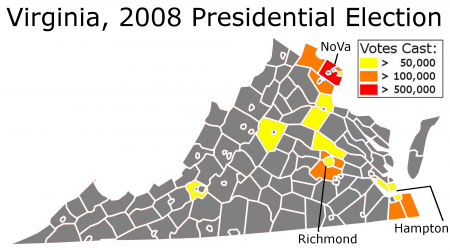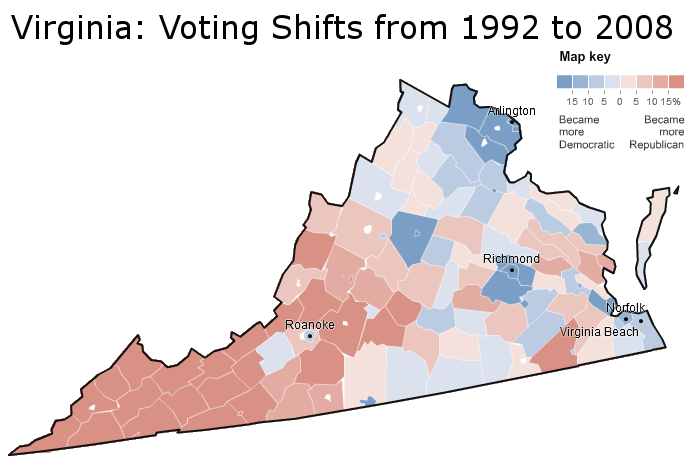This is the last part of a series of posts analyzing the swing state Virginia, which aims to offer some concluding thoughts. The previous parts can be found starting here.
Conclusions
As a state, Virginia’s population has always been located in three metropolitan areas: the Northern Virginia suburbs south of Washington D.C., Richmond and its suburbs, and the communities surrounding Hampton Roads. Together these three places compose more than half of Virginia’s electorate:
In all three metropolitan areas, Democrats have been improving their margins.
More below.
Virginia’s suburbs, expansive and traditionally Republican, have shifted leftwards with startling quickness. This movement has been most apparent in the largest of its suburbs, rich and diverse Northern Virginia. The addition of NoVa to Virginia’s heavily Democratic, heavily black cities has given the Democratic Party a coalition that has won a number of recent elections.
Not everything has gone badly for the Republican Party. They have captured a formerly loyal Democratic constituency – the Appalachian west, which voted Democratic based on economic appeals. Moreover, they still dominate the rural whites who in bygone days voted Democratic:
Thus, Virginia today is a state in change, like most states. Parts of it are shifting left and parts of it are shifting right; in aggregate, the effect has been to change it from a solidly Republican to swing state. Undoubtedly, other states will and are moving in the opposite direction.
Colorado, the next state in this series, is probably not one of those Republican-shifting states.
–Inoljt, http://mypolitikal.com/


I think it may be a bit premature to end your voting pattern behavior at 2008, as that has the potential to be a flukey year featuring historic turnout (especially African-American turnout) and anger at Bush. For instance, while NoVa is undeniably going more Democratic, especially in that timeframe, Hampton Roads (and Virginia Beach in particular) is a lot more unclear. Glenn Nye, who represents all of VB, is one of the most endangered incumbents.
I realize that you didn’t intend for this to be the final chapter in Virginia’s demographic analysis, and that the next Presidential election is two years away. I’m just saying, I wouldn’t be surprised to see many of the mid-blue shades revert to a lighter blue, and many of the white-blue shades turn white-red, after the 2012 election.
This November we’ll see just how much these areas have really swung. The NoVA trend has been a long time coming. As for the other areas, I think 08′ will be the D peak for a while. In 2 years we will have a much clearer picture of what has solidly changed. Look at the recent Governer’s election for some sobering data. Or the House of Delegates for that matter.